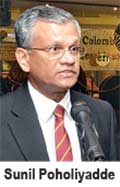
By Steve A. Morrell
Chairman Colombo Rubber Traders Association, ( CRTA) Sunil Poholiyadde said recently at the Annual General Meeting (AGM ) of the CRTA that the current performance of the industry was not at optimum. Comparing crop performances in 2015 and 2016 he reported a 79 million kilo drop in production in 2016. Additionally, he also expressed surprise at a very nearly 50 percent drop in production of natural rubber .
He confirmed that 70 percent rubber originated from rubber small holders, who did not work their lands because of poor prices last year, seriously affecting production. Prices dropped to Rs. 200. per kilo which rendered such lands liabilities than assets. Additionally, small holders are now felling their rubber trees for timber for the lucrative furniture market. Consequences of such action will gravely affect production. Long term effects would be detrimental to the rubber industry.
Poholiadda also said about 2500 hectares have been identified for acquisition as ex rubber lands to be administered by Regional Plantation Companies for expansion for industrial purposes.
The drop in prices and reduced extents of rubber plantation resulted in a dismal overall performance. He added Regional Plantation Companies have continued their re-planting programmes but the main production sector, who are the small holders, who were accustomed to sales prices of Rs.600. per kilo, are now faced with insolvency.
Poholiadda alluded to the Rubber Master Plan and the expected increase in production by 2045 of 300,000 kilos, inclusive of production of value added products for the export market. He said by that time rubber would contribute about 5 billion dollars in forex earnings.
Secretary, Ministry of Plantation Industries Lakna Paranawitharna deputizing for Minister Naveen Dissanayake, who was unwell, confirmed the Rubber Master Plan was operative and its progress was on-going, although he said its progress was slow.
At discussion he confirmed the Monaragala rubber project was now productive and some 3000 hectares of new planting were now productive. The target area was 5000 hectares.
He, however, said a current shortage of labour was a serious phenomenon affecting production; the need to address this problem was imperative if the industry was to progress.
The Rubber Master Plan was not the sole responsibility of the ministry but should in large part be a collective effort of the private sector as well. Additionally, rubber research would be re-structured to ensure continuous progress.
- Island.lk






















